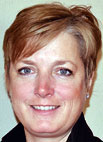
Hope comes in many different forms for many different people but probably four-hoofed is not most folks’ first notion when the word is mentioned. Horses of Hope, a therapeutic riding program, located just south of Buffalo, Mo., is working hard to change that perception.
Shelly McColm is director of the 15-year-old program which, began in Baxter Springs, Kan., and has operated its second location in Buffalo on 19 acres for six years. She and Vallerie Sweeton, the head riding instructor, are co-founders of the growing endeavor. “We started in Kansas,” Shelly explained recently in the lobby of their indoor arena. “Several things came together at once. Our friends’ child struggled with Fragile X syndrome and my daughter, Mycah, was a little girl then, taking riding lessons. Vallerie was a paraprofessional in the school system, working with special needs kids and when my husband suggested we start a therapeutic riding program, saying ‘you both love horses,’ it was like the lights went on. We started with a $10,000 grant and have been going ever since.”
Currently, Horses of Hope has eight horses, which are mainly stock and Quarter Horses. “Most are retired show horses that have been donated to our program,” Shelly continued. “They have a good work ethic and that makes them easy to work with.”
Vallerie Sweeton is a physical therapy assistant as well as a certified therapeutic riding instructor. She works in close association with a physical therapist and this summer they will also be assisted by an occupational therapist. Like all of their staff, Vallerie is certified with PATH, the Professional Association of Therapeutic Horsemanship, previously known as the North American Riders for the Handicapped Association.
“We have a small staff of seven and wonderful volunteers,” Vallerie explained. “It’s more about the quality of volunteers than the numbers. We have been really blessed all 15 years, with fabulous volunteers. Our volunteers include retired folks and students from Southwest Baptist University as well as people who just love kids and love horses. Volunteers have to be at least 14 years old, someone who feels comfortable walking with a horse and someone who can continuously walk beside a horse for 30 minutes. They allow us to do what we do here, which includes equine-assisted activities, therapeutic riding, hippotherapy, therapeutic driving, equine-facilitated learning, working with at-risk students as well as personal growth and development courses such as leadership development.”
Vallerie continued, “Therapeutic riding is about horsemanship, to help the rider learn skills that lead towards the goal of becoming a better rider. Hippo is the Greek word for horse and hippotherapy is utilizing the movement of the horse to work towards specific therapy goals in physical therapy. In all cases, we work and look for the best in each rider’s ability. For some, it might be total independence; for others, it may involve learning verbal commands and improving their verbal skills to work in conjunction with other daily life skills.”
A school group from Buffalo arrived by bus and was quickly integrated into the equine-centered activity surrounding them on all sides. They began with a meeting in which the three primary rules were discussed: safety, fun and being nice to horses, people and other animals. They then split into two groups, one of which would ride while the other went to a separate area known as the OK Corral. There, they learned about character education, caring, respect and grooming using miniature horses. This particular Monday included two school groups, elementary in the morning and high school in the afternoon, with a total of 20 riders working with the horses before the day is finished.
“We have a lift here for folks in wheelchairs and a ramp that works well for the physically fit but those who may have fear issues with the mounting and dismounting,” Vallerie added. “We also have able-bodied riding instruction for all ages, children and adults and summer camps, too. We do leadership development for board of directors groups, for instance, and we also have a therapeutic driving program using carts, which is designed for people who may not be able to ride but who can benefit greatly from learning to drive a horse-powered cart. We have two sets of lines so the instructor may stay in control the whole time, if necessary. It is all about what the individual client needs.”
One of the school teachers commented to another with a smile as she watched one of her current students ride off. “We brought a boy here last year who had pretty severe autism. Once he started coming here, the difference in that boy was amazing.”
“This is our passion,” Vallerie concluded. “Funding is always a challenge and it’s a lot of work but the rewards far outnumber the challenges and when these kids smile – that says it all.”







